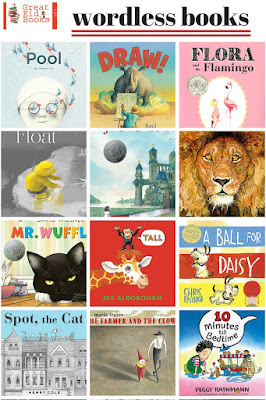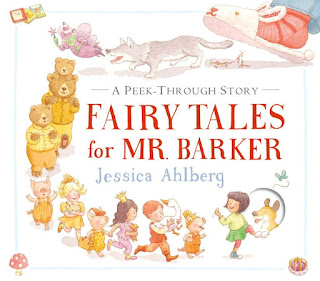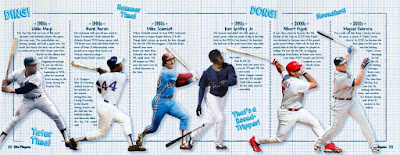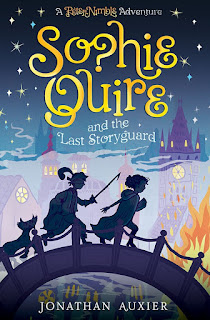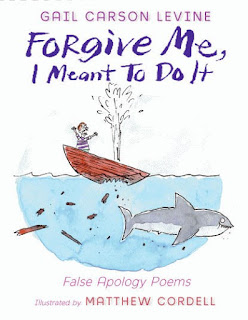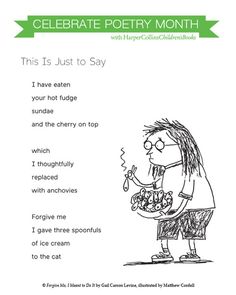new posts in all blogs
Viewing Blog: Great Kid Books, Most Recent at Top
Results 26 - 50 of 890
.jpeg)
A site to help parents learn about great books for their kids ages 4 - 14. I'm the Friday Librarian at Redwood Day School, an independent K-8 school in Oakland, CA.
Statistics for Great Kid Books
Number of Readers that added this blog to their MyJacketFlap: 8
Do you enjoy reading wordless books with your child? Do you like the freedom to make up your words and stories, or does it leave you a little lost? Wordless picture books tell the stories only through the illustrations, and they put much more of the storytelling role onto the reader.
Wordless books can be a delight and a challenge to read with children -- here are a few of my tips:
1. Encourage children to make up the story. There is no "right" or "wrong" way to read these books.
2. Spend time looking at the cover and talking about the book's title. What do you think this story is going to be about? What do you notice?
3. Take a "picture walk" through the pages, looking at the pictures and talking together about what you see.
4. Slow down and notice the details together. Talk about the characters' expressions, the setting, the use of color. What does the illustrator want us to notice?
5. Encourage your child to use different voices, add sound effects and use interesting words as they tell the story. Have fun!
These conversations will enrich your child's storytelling, bringing joy and meaning to the experience.
Here is a collection of my favorite wordless books, new and old, with a brief description (based on the publisher's description).
- 10 Minutes till Bedtime, by Peggy Rathmann -- A boy's hamster leads an increasingly large group of hamsters on a tour of the boy's house, while his father counts down the minutes to bedtime.
- A Ball for Daisy, by Chris Raschka -- A dog has fun with her ball, until it is lost. This story is about what it is like to lose something special, and find a friend.
- Draw!, by Raúl Colón -- A boy who is confined to his room fills his sketch pad with lions and elephants, then imagines himself on a safari.
- The Farmer and the Clown, by Marla Frazee -- A farmer rescues a baby clown who has bounced off the circus train, and takes very good care of him until he can reunite the tot with his clown family.
- Flora and the Flamingo, by Molly Idle -- In this wordless book with interactive flaps, a friendship develops between a girl named Flora and a graceful flamingo, as they learn to dance together.
- Float, by Daniel Miyares -- A boy loses his paper boat in the rain, and goes on an adventure to retrieve it.
- Good Night, Gorilla, by Peggy Rathmann -- An unobservant zookeeper is followed home by all the animals he thinks he has left behind in the zoo.
- Journey, by Aaron Becker -- A lonely girl draws a magic door on her bedroom wall and through it escapes into a world where she creates a boat, a balloon, and a flying carpet that carry her on a spectacular journey.
- The Lion and the Mouse, by Jerry Pinkney -- In this wordless retelling of an Aesop fable set in the African Serengeti, an adventuresome mouse proves that even small creatures are capable of great deeds when she rescues the King of the Jungle.
- Mr. Wuffles!, by David Wiesner -- Mr. Wuffles ignores all his cat toys but one, which turns out to be a spaceship piloted by small green aliens.
- Pool, by JiHyeon Lee -- Two shy children meet at a noisy pool and dive beneath the crowd into a magical undersea land, where they explore a fantastical landscape and meet various creatures.
- Spot the Cat, by Henry Cole -- A cat named Spot ventures out an open window and through a city on a journey, while his owner (and the reader!) try to find him.
- Tall, by Jez Alborough -- All the jungle animals help a very little monkey to feel that he is tall.
- The Typewriter, by Bill Thomson -- Three children find a typewriter on a carousel, and begin an adventure that helps them discover the wonder of words.
If you make a purchase using the Amazon links on this site, a small portion goes to Great Kid Books. Thank you for your support.
©2016 Mary Ann Scheuer, Great Kid Books
Many of my students are drawn to realistic fiction because it gives them a chance to immerse themselves in someone else's story. In fact, a recent study has shown that reading literary fiction helps improve readers' ability to understand what others are thinking and feeling (see this article in Scientific American).
Laura Shovan's novel in verse, The Last Fifth Grade of Emerson Elementary, is full of distinct voices that prompt us to think about different students' unique perspectives. It's one my students are enthusiastically recommending to one another.
The Last Fifth Grade of Emerson Elementary
by Laura Shovan
Wendy Lamb / Random House, 2016
Google Books preview
Your local library
Amazon
ages 9-12
*best new book*
Eighteen fifth graders keep poetry notebooks chronicling their year, letting readers peak into their thoughts, hopes and worries as the year progresses. Fifth grade is a momentous year for many students, as the finish elementary school and look ahead to all the changes that middle school brings. This year is particularly full of impending change for Ms. Hill's class because their school will be demolished at the end of the year to make way for a new supermarket.
Through these short poems, Shovan captures the distinct, unique voices of each student. The class is diverse in many ways--racially, ethnically, economically, and more. At first, I wondered if I would really get to know the different students since each page focused on a different child; however, as the story developed, I really did get a sense of each individual as well as the class as a whole. Shovan creates eighteen distinctive individuals--with personalities and backgrounds that we can relate to and envision. And these experiences shape how each individual reacts to the year.
I particularly love novels in verse because they allow readers a chance to see inside character's thoughts without bogging the narrative down in too much description. As researcher David Kidd said (in this
Scientific American article), literary fiction prompts readers to think about characters: "we’re forced to fill in the gaps to understand their intentions and motivations.” This is exactly what ends up being the strength of Laura Shovan's novel.
The funniest thing, for me personally, has been the shocked look of many of my students when I show them this cover. You see, our school is called Emerson Elementary School. "This is a real book?!?!" they say, incredulously. I know my students will particularly like the way these students protest the plans to demolish their school, bringing their protest to the school board.
As you can see in this
preview on Google Books, this collection of poems slowly builds so readers get a sense of each student in Ms. Hill's fifth grade. The poetry feels authentic, never outshining what a fifth grader might write but always revealing what a fifth grader might really be thinking.
I highly recommend the audiobook for
The Last Fifth Grade of Emerson Elementary. The diverse cast of Recorded Books brings alive each character. This would make a great summer listen, or a great read-aloud for the beginning of the school year.
The review copy for the audiobook was purchased from Audible and for the print copy it was borrowed from my local library. If you make a purchase using the Amazon links on this site, a small portion goes to Great Kid Books. Thank you for your support.
©2016 Mary Ann Scheuer, Great Kid Books
My students love sharing fairy tales and they have so much fun reading new twists on old favorites. Two new favorites emphasize humor and downplay the traditional tales' darker sides, making them perfect for preschoolers and kindergartners.
With charming rhymes, Underwood creates a scene where fairytale villains come together at the end of a long day to share dinner and bedtime stories. The baddies really shine when given a chance.
Baddies sit politely dining,
no one throwing food or whining.
All day long they must be vile;
now, at night, they chat and smile.
The evil queen puts on pajamas, while the wolves brush their teeth (well, their fangs). The sweet rhymes and soft illustrations contrast perfectly with baddies' reputation--who would think that the troll enjoys a bubble bath after a hard day waiting for the three billy goats gruff?
 |
"Evil queen, take off your crown;
trade pajamas for your gown.
Tuck your poisoned fruit away.
Find Snow White another day." |
Children will enjoy recognizing favorite tales and spotting details from each in the illustrations. I absolutely agree with the
BookDragon's review: "Deborah Underwood and Juli Kangas are a delightfully subversive team, proving even the meanest baddies need time to relax and recharge."
Fairy Tales for Mr. Barker: A Peek-Through Story
by Jessica Ahlberg
Candlewick, 2016
Your local library
Amazon
ages 4-7
Young Lucy chases her dog through fairy tale lands, dodging bad guys along the way. Even before you get to the title page, young Lucy asks her dog, "Do you want to hear a story, Mr. Barker?" But the pup is distracted by a butterfly, and takes off out of the open window. When Lucy follows him, she enters one new fairytale world after another -- and readers must guess (along with Lucy) where she is.
 |
| "Where are we?" asked Lucy. She saw a broken chair, three bowls of porridge, and a little golden-haired girl." |
Just as the villain enters the scene, Lucy knows that it's time to leave and invites her new friends to join her. Soon she's followed by Goldilocks, the three little pigs and Jack, with the three bears, the wolf and the giant all chasing them. Ahlberg uses the cutouts very effectively, engaging young readers and prompting them to wonder what's on the other side.
In each new scene, she provides just enough clues for readers to guess which tale Lucy has entered. This encourages young readers to take part in the story, actively engaging with the text. Jessica Ahlberg is the daughter of Allan and Janet Ahlberg, whose classic The Jolly Postman is one of my all-time favorite fairytale mashups. Jessica told
Publisher Weekly,
“I think fairy tales are a great shared knowledge, and so if you assume prior knowledge you can play with expectations or make it into a guessing game, as I did in Mr. Barker. I think the fact that the tales are ‘universal’ gives the child reader power. I think it can be fun for them to spot changes, or mistakes, or to know what’s going to happen next. It gives them a bit of control, perhaps. Similarly, my protagonist is able to help the fairy tale people she meets, because she knows their stories and knows what’s going to happen before they do.”
It is interesting that both books draw only from European folktales and fairytales. The illustrations show mainly white characters, although Ahlberg draws both Lucy and Sleeping Beauty with brown hair and slightly darker skin tones.
The review copies were kindly sent by the publishers, Time, Inc. (via BlueSlip Media) and Capstone Books. If you make a purchase using the Amazon links on this site, a small portion goes to Great Kid Books. Thank you for your support.
©2016 Mary Ann Scheuer, Great Kid Books
Baseball season is in full swing. The weather has been fabulous for baseball viewing. Share these new books with kids who love baseball stats, stories and players.
Baseball: Then to Wow!
by the editors of Sports Illustrated Kids
Time, Inc. Books, 2016
Your local library
Amazon
ages 7-12
Whether it’s looking at changes in equipment or comparing playing styles then and now, this high-interest book provides opportunities for fans to analyze different aspects of the game. Emerson 4th and 5th graders are loving this book. Here's one student's favorite page -- showing the way baseball gloves developed from the 1880s to present day.
Great layout, photographs and illustrations engage kids and help them see the progression of the game over the past 150 years. The information is detailed, but broken into short chunks that kids can absorb.
Excellent photographs will draw kids in, but it's really the text that will keep them coming back for more. Even die-hard fans will learn new aspects of the game's history, equipment and players.
Check out this full review by my friend Brenda Kahn over at
Prose & Kahn to read more about this new Sports Illustrated baseball book. She calls it "a fine addition to any collection. The clean layout provides an organized, humorous journey for the eyes."
Baseball Stats and the Stories Behind Them
What Every Fan Needs to Know
by Eric Braun
Capstone, 2016
Preview on Google Books
Your local library
Amazon
ages 7-12
Baseball fans love comparing stats to get a handle on how their favorite teams and players are doing. Braun introduces kids to the math behind the stats with this clear, high-interest introduction covering everything from basic batting averages to slugging and fielding percentages. Full of up-to-date stats and photos.
Look through this preview on Google Books to get a sense of the math and text -- I think this will be right for 4th and 5th graders, although some younger students will definitely enjoy reading this, perhaps with more parent support.
Examples are current, up-to-date stats. I especially like how the text explains both the math and the significance of the stats. Braun really captures the excitement of the game, and the way that stats help fans compare players.
If you're looking for a baseball math book for younger fans, you might check out
The Math of Baseball, by Ian Mahaney.
The review copies were kindly sent by the publishers, Time, Inc. (via BlueSlip Media) and Capstone Books. If you make a purchase using the Amazon links on this site, a small portion goes to Great Kid Books. Thank you for your support.
©2016 Mary Ann Scheuer, Great Kid Books
I love traveling, going to see new places and experience new things. But traveling with kids, well that takes a special sort of patience, humor and--above all else--preparation. I adore, adore, adore Lisa Brown's newest picture book, The Airport Book, precisely because she celebrates the adventure of traveling by airplane with kids, full of so many things to look at and so many stories within the main story.
The Airport Book
by Lisa Brown
Roaring Brook / Macmillan, 2016
Your local library
Amazon
ages 2-8
*best new book*
"Don't forget monkey!" a mom reminds her family, as they are finishing their packing. "Of course I won't forget monkey!" the dad replies, and kids will smile as the little girl announces proudly, "I pack monkey!" Right from the beginning, Brown engages readers with the story, encouraging readers to predict just what's going to happen when monkey goes missing.
 |
"Monkey monkey monkey!"
"Did you forget to pack monkey?" |
Young readers will start by following the toddler's cry for her beloved monkey. With an adult or older reader, they will then read the cool, composed voice explaining the experience. I like to think of this as the big brother coaching the little sister through the experience.
"Inside the airport you stand in lines. You stand in lines to get your ticket. you stand in lines to check your bags. There are lines for the restrooms. There are lines to go through security."
Linger on the page for a while, and you'll notice that there are all sorts of little stories within the central story. Readers will have a great time choosing a character and seeing what's happening to them in the next scene.
 |
| "You squeeze into your seat. Some bags go up top. Some bags go underneath." |
Brown captures the busy nature of airplane travel without leaving the reader overwhelmed. Part of this is the reassuring, matter-of-fact tone of the main narrator and of the parents on the journey. Partly it's the satisfying story arc, both for the main character and the smaller stories. She balances detailed illustrations with a few large, open spreads of the airplane flying in blue sky.
I especially love how diverse Brown's airplane travelers are--in so many ways. The main family is multiracial, with a black dad, white mom, two brown kids. There are people of different ethnic and racial groups. There is a working mom, constantly on her cell phone. A dad is traveling alone with a little baby. A woman is traveling independently in a wheelchair. And yet none of this diversity draws attention to itself--it seems effortless and natural, and yet Brown carefully, thoughtfully includes in so many ways.
Check out these stellar reviews:
Illustration copyright © Lisa Brown, 2016, shared with permission of the publisher. The review copies were kindly sent by the publisher, Roaring Brook / Macmillan. If you make a purchase using the Amazon links on this site, a small portion goes to Great Kid Books. Thank you for your support.
©2016 Mary Ann Scheuer, Great Kid Books
.jpeg?picon=2320)
By: Mary Ann Scheuer,
on 5/9/2016
Blog:
Great Kid Books
(
Login to Add to MyJacketFlap)
JacketFlap tags:
Add a tag
Local artist and author Lisa Brown has a deep and abiding love for picture books. Her newest book The Airport Book comes out tomorrow and is one of the best books of 2015! Brown not only writes and illustrates books, she also teaches illustration at the California College of the Arts. Last year, we had the BEST author visit at our school with Lisa (read all about it here).
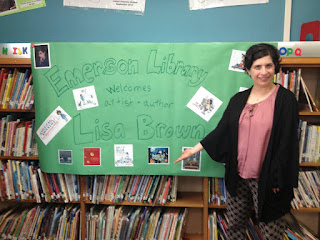 |
| Lisa Brown at Emerson |
I spent a lovely afternoon talking with Brown about the power of picture books and sharing stories with children. This interview was originally published at
Parents Press in March 2016. My words are in italics, Lisa's follow.
I’m fascinated by the experience that reading a picture books leads to, especially between parent and child. What do you see as exciting and unique to this experience?When I talk with people about picture books, I always say how there are two texts going on: the visuals and the words. A child on your lap is looking and reading the pictures while you are reading the text. There’s an interaction and an interactivity that happens because you can point things out to the child and the child can point things out as well.
Oh, that's so true! And it's one of the reasons why children have loved reading The Airport Book with me, lingering over each page. With young kids, I start by pointing things out -- but then they jump right in. Older kids start talking and pointing things out right away! |
| The Airport Book, by Lisa Brown |
How do you encourage parents to bring picture books alive for young children when they read them aloud?It’s funny--there are books I read today that I only hear my father’s voice or my grandmother’s voice reading aloud. I hear my father reading “The Monster at the End of This Book” by Jon Stone. He would read it literally--when Grover was covering the pages with bricks, my father would struggle lifting and turning the page and I loved the drama he brought to it.
Illustrators and authors create a moment to pause and linger with a page turn, a moment to anticipate what comes next. My father was reinforcing the art and the pictures as he read this story, and the whole story became real.
As you turn the page, do you just start reading with a child?Yes, but… you stop often and ask questions. What do you see? What do you think the characters are doing? Why do they want to do that? Have a dialog with the pictures and with the child. In a good picture book, the text is not going to tell you everything. The pictures ideally carry half of the weight of the story. An adult should let the child read the pictures and talk about the story.
Do you think about the age of your audience as you create books?Not really. Picture books are meant to be read with an adult and they work on many levels. I can create a story about Egyptology (which is sophisticated) and mummies (which are dead things!) and make it for children because they will have an adult reading it with them.
Yes, my students love Mummy Cat! And it also appeals to older children who want to figure out the puzzle on their own. So many older children I know still enjoy picture books. I hope parents encourage that with children and don’t push them to leave picture books aside as their reading develops.I tell my art students that a picture book is a piece of mass produced fine art : in most cases it is the only exposure a child will have to fine art. But it’s exposure that’s frequent and intimate, as opposed to a museum.
Frequent and intimate, yes. It reminds me of the phrase, “Again, again!”Repetition is important. I think it brings comfort. I think it brings mastery, noticing more details each time children interact.
Which book did your son ask for again and again?He loved
Richard Scarry’s Best Storybook Ever so much when he was little that we had to hide it because it became so boring for us to read as parents. So we saved it to dole out in airports when we really needed him to be quiet and engrossed.
That’s so funny--The Airport Book reminds me so much of the wonderful detail in Richard Scarry’s books. It’s like this is coming full circle! Thank you so much, Lisa, for a lovely afternoon. I can't wait to share
The Airport Book with everyone! Many thanks to the publisher, Roaring Brook / Macmillan for sharing the review copy and supporting our work here. If you make a purchase using the Amazon links on this site, a small portion goes to Great Kid Books. Thank you for your support.
©2016 Mary Ann Scheuer, Great Kid Books
.jpeg?picon=2320)
By: Mary Ann Scheuer,
on 5/3/2016
Blog:
Great Kid Books
(
Login to Add to MyJacketFlap)
JacketFlap tags:
Add a tag
Todd Parr's books are a constant favorite at our school library. Todd celebrates all kinds of kids, all kinds of families. He makes us feel good with his positive messages and bright artwork. If you've liked his other picture books, you're going to love Todd's newest book: Teachers Rock!
Teachers Rock!
by Todd Parr
Little, Brown, 2016
Your local library
Amazon
ages 3-8
With simple text and playful illustrations, Todd Parr celebrates teachers for the love, enthusiasm and encouragement they bring their students each and every day. By looking at everyday activities, Todd calls out so many of the ways that teachers impact their students.He's goofy and makes kids laugh, and he helps us laugh at how silly we all are. And he's also absolutely sincere and genuine, sharing this love and appreciation with all students and teachers.
 |
| "Teachers encourage you to be creative." |
I'd love to welcome Todd to share a little bit about his creative process with us and what inspired him to write this story.
1. Who was a special teacher for you? How did she/he inspire you?
I’ll never forget Miss Dona, my second second-grade teacher (yes, I had to repeat the second grade). She helped me learn to read. She challenged me to stand up in front of the class and speak. She taught me how to tell my left hand from my right. She took my marbles (the kind you played with and traded) so I wouldn’t get distracted. She even taught me how to make butter.
2. You're so enthusiastic and supportive! How do you keep this positive spirit?
I look at life as it’s for living. Not for just getting by. I’m pretty much like everyone else. I have bad days too.
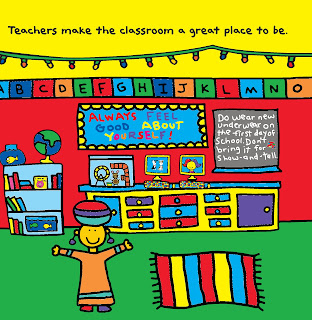 |
| "Teachers make the classroom a great place to be." |
3. The writing process can be so hard for kids. Can you share a picture of messy first draft, so they see a bit of your process?Since I do everything on the computer now. I can correct my mistakes instantly. It’s on of the reason I love working this way. I have a short attention span and want to see things come together instantly.
4. How do you get into a place or mindset for writing your poetry? Do you have any habits you could share with young writers?
I write and draw when I am feeling excited and creative about something. There are no rules with me. Don’t force things.
The end.
Love, Todd
I love the way Todd talks about wanting to correct his mistakes and move on quickly. I think many of our 3rd graders would absolutely agree that this has been one of the best things about learning to use the computer for their writing.
I'm going to keep this short. Enjoy celebrating the teachers in your life. Take time this week (and always) to tell them how much you appreciate them.
Read more about Todd and his celebration of
Teachers Rock! over at the
Nerdy Book Club and have fun watching this interview via KidLitTV:
Many thanks to Todd for making time to share his thoughts with us. Many thanks to the publisher, Little Brown for sharing the review copy and supporting our work here. If you make a purchase using the Amazon links on this site, a small portion goes to Great Kid Books. Thank you for your support.
©2016 Mary Ann Scheuer, Great Kid Books

.jpeg?picon=2320)
By: Mary Ann Scheuer,
on 5/2/2016
Blog:
Great Kid Books
(
Login to Add to MyJacketFlap)
JacketFlap tags:
Add a tag
Occasionally I read a story that makes me yearn to reach back through time and hand it to the 11 year old me that loved nothing more than hiding out behind the couch lost a favorite book. Sophie Quire and the Last Storyguard has me thinking about just what I liked reading when I was a kid. I loved reading fantasies that took me to far off worlds, showed me protagonists who battled great forces of evil, and triumphed using both brains and courage. I also loved fantasies that made me think just a little more deeply about our own world.
Sophie Quire and the Last Storyguard
by Jonathan Auxier
Abrams, 2016
Your local library
Amazon
ages 9-12
*best new book*
Sophie is a girl after my own heart--a steadfast friend, willing to stand up for what she believes in. Above all else, she loves books and the stories they hold. Sophie works as a bookmender in her father's shop, caring for old books, helping to make sure they can share their stories with more of the town's citizens. But the town is turning on Sophie and her father: the Inquisitor is leading a movement to banish all nonsense from their town, and calling for all citizens to bring their storybooks to the great Pyre to be burned. Sophie is thrust into the role of protecting the magical Book of Who when Peter Nimble rescues her from arrest by Inquisitor Prigg and presents her with this amazing book.
Sophie's mother died protecting the
Book of Who, and now Sophie must protect it from Inquisitor Prigg's prying grasp. She is joined by Peter and his trusty companion Sir Tode, as they uncover the mystery of the books of the Four Questions: Who, What, Where and When. While this new book is definitely a companion to Auxier's
Peter Nimble and His Fantasic Eyes (
my review here), Sophie Quire stands alone very well--Auxier tells her own story, and Peter plays a supporting role.
Children who love escaping into an adventure will definitely enjoy this--think of fans of Adam Gidwitz's Grimm series, or Rick Riordan's Percy Jackson series. I especially love how Auxier's characters are layered and developed, letting these characters live on in my mind. Good is tainted by hubris, greed or fear. Evil has roots in old wounds and competition. You have to understand someone's backstory to see where they're coming from. Even stories themselves can come alive in the hands of the right reader.
Jonathan's
visit to our school was one of the best visits ever. If you have the opportunity to Skype with him or to have him talk with your students, definitely jump at it. In the meantime, enjoy reading the first few chapters of
Sophie Quire (via
Google Books):
I want to end by sharing a bit of an interview Auxier did over at
Word Spelunking with Aeicha. If you enjoy this, definitely read the whole interview.
What three words best describe your book, Sophie Quire and the Last Storyguard?
Auxier: Mysterious, wonder-filled, bookish
Can you give us your best one sentence pitch to convince young readers, especially reluctant readers, to give Sophie Quire and the Last Storyguard?
Auxier: Sophie Quire is a swashbuckling adventure about a girl who must hunt down and protect a set of mysterious books that can answer any question asked of them. I was a reluctant reader growing up, and wrote Sophie because it’s the book I wish someone had given me when I was that age. Also, it has a ton of monsters in it.
Favorite chapter?
Auxier: My favorite chapter might be “Highway Robbery” in which Sophie finds herself being kidnapped in a carriage on a moonlit road—only to have a highwayman show up and kidnap her again. Needless to say, things do not turn out as planned for said highwayman!
The review copies was kindly sent by the publisher, Abrams. If you make a purchase using the Amazon links on this site, a small portion goes to Great Kid Books. Thank you for your support.
©2016 Mary Ann Scheuer, Great Kid Books
.jpeg?picon=2320)
By: Mary Ann Scheuer,
on 4/29/2016
Blog:
Great Kid Books
(
Login to Add to MyJacketFlap)
JacketFlap tags:
Add a tag
I'm so happy to welcome the utterly delightful Lee Wardlaw to talk about poetry, pets and her creative process. Even better, we are celebrating National Hairball Awareness Day (April 29th) and National Adopt a Shelter Pet Day (April 30th)! So snuggle up with your favorite furry friend and let's check in with Lee.
Lee Wardlaw claims her first spoken word was ‘kitty’. Since then, she's shared her life with more than two-dozen cats and published more than two-dozen, award-winning books for young readers. Lee has won many awards, including the
Lee Bennet Hopkins Poetry Award and the
Myra Cohn Livingston Award for Poetry, both for the delightful picture book
Won Ton: A Cat Tale Told in Haiku.
The newly released companion title,
Won Ton and Chopstick, is a 2015 NCTE Notable Poetry Book and a BookSource Scout Award Winner for Children's Poetry. Lee lives in Santa Barbara, CA, with her family, which includes two dog-disdaining cats. Welcome, Lee!
1. How do you get into a place or mindset for writing your poetry? Do you have any habits you could share with young writers?I've found that a long walk works best to get me started. After I've been walking for a few minutes, my mind slips into a trance, and I just let images and words and sensorial experiences bubble up from my subconscious. (Some of the best dialogue between characters in my novels starts out that way, too!) I'll walk for an hour or more, and when I get home I don't even remember the roads I took or the homes I passed. I just have a gush of ideas that need to be drained into the closest notebook. Often, I get the first line and the last line of a poem that way, which is helpful because I never start writing the actual poem until I know where I'm going with it.
If a walk isn't convenient, I curl up in a chair with a notebook and a cat, and brainstorm. (I also brainstorm in restaurants, or in my car, or wherever I am when I have a few free minutes.) Sometimes, the brainstorms are random scribbles; other times, I actually begin with specific categories, and play off those. Here's a picture of one of the brainstorms I did for my newest book
Won Ton and Chopstick: A Cat and Dog Tale Told in Haiku. I'm always been a cat person, so I don't know much of dogs. In this storm session, I wrote down everything I could think of about dogs to get an idea of what the puppy in the story would be like, and what kinds of puppy-isms might contribute to the plot.
 |
| Lee's brainstorming for Won Ton and Chopstick |
This second photo shows another storm session I had on a placemat when out for a casual dinner with my husband and son. (Yes, my family is used to me 'disappearing' from conversations to jot stuff down. It's my middle-aged version of a teenager staring at his cell phone.)
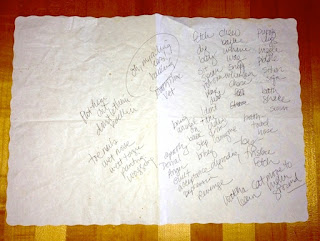 |
| Lee's dinner brainstorming |
2. I love sharing descriptive words with kids is there a word that's been on your mind lately that's particularly delicious?It depends on the mood I'm in! If I'm feeling silly, I delight in words such as 'weasel' or 'cumberbund'. I also like words that when you see them written, you're not quite sure how to pronounce them, like Phoebe or calliope. (I love the word
calliope! Say it out loud: cah-LIE-oh-pee. Listen to the sounds…feel how your mouth purses and stretches!) I enjoy making up words, too, when I can't find one that exactly fits what I'm trying to say. Not long after my husband and I got married (33 years this summer), I came up with the word 'miffled' to describe how I felt whenever he'd come home late for dinner without calling first. 'Miffled' was a combination of 'miffed' and 'ruffled'. (I now see that 'miffled' is in the Urban Dictionary as being a combo of 'miffed' and 'baffled'.) In my middle grade novel
101 Ways to Bug Your Teacher, I use the word 'goose-blisters' to describe a particularly scary and shaming moment - - and how that moment feels physically to my protagonist.
3. What are three books of poetry you'd like to see in every child's home, for them to dip into whenever they want?I love-love-love
All the Small Poems and 14 More by Valerie Worth. Worth is a master at writing succinct, simple poems about common, ordinary objects - - a key, a coat hanger, a thread of string - - and exalting them to extraordinary things.
Where the Sidewalk Ends by Shel Silverstein is, of course, a MUST for its silly wit and wisdom and poems that everyone can relate to!
Last, I think every household should have a good book of nursery rhymes. One of my favorites is
My Very First Mother Goose, edited by Iona Opie (the noted folklorist) and endearingly illustrated by Rosemary Wells. (I'm a huge Wells fan. I love the sweet exuberance of her bunnies, and kittens, and bears.)
4. Is there a poem you have memorized that you can share a snippet with us? Maybe it's something you say to yourself when you need encouragement or just when you want to delight in the power of words.My memory isn't what it used to be, but I can still recite by heart "
Three Cheers for Pooh" by A.A. Milne, a poem I've loved since age 3 or 4. It never fails to make me giggle. I can also recite "The
Walrus and the Carpenter" and "
Jabberwocky" by Lewis Carroll. The first stanza of "Jabberwocky" appeared in a magazine in 1855, and was titled "Stanza of Anglo-Saxon Poetry". Later, Carroll expanded it, turning it into a story poem. Here's that first stanza:
'Twas brillig, and the slithy toves
Did gyre and gimble in the wabe;
All mimsy were the borogoves,
And the mome raths outgrabe.
I love the word play in this poem, especially since so many of the words Carroll invented are now in our dictionary - - words such as "chortle", "burble" and "galumph". How frabjous is that?!
Thank you so much, Lee! Thank you so much for sharing your love of poetry with children and families. I love this video of you reading Won Ton and have to share it with readers.
If you make a purchase using the Amazon links on this site, a small portion goes to Great Kid Books. Thank you for your support.
©2016 Mary Ann Scheuer, Great Kid Books
.jpeg?picon=2320)
By: Mary Ann Scheuer,
on 4/27/2016
Blog:
Great Kid Books
(
Login to Add to MyJacketFlap)
JacketFlap tags:
Add a tag
Growing up, I regularly confided in my cat Tippy Toes--he always listened patiently, reassured me with his rhythmic purring and never told anyone else my secrets. These three poetry books capture the personality of cats and bundle them up in short, evocative bursts that can entice even picky children.
In a series of short poems, a cat tells the tale of his adoption from an animal shelter. The cat's personality comes alive, both with Wardlaw's humor and her sly observations. I love these set of poems from the opening in the shelter:
The Shelter
Nice place they got here.
Bed. Bowl. Blankie. Just like home!
Or so I've been told.
Gypsy on my left.
Pumpkin, my right. Together,
we are all alone.
Visiting hours!
Yawn. I pretend not to care.
Yet--I sneak a peek.
Cat lovers who ponder the personalities of different cats will enjoy Rosen's haiku. I'd recommend this for children in grades 2-5 because these short poems are more reflective and not driven by a story. Each poem spotlights a different breed of cats; the brevity and poignancy capturing the feline essence. Here are two of my favorites:
Turkish Angora
whooshing down the hall:
Angora, then her all-white
dust devil of hair
Balinese
on the windowsill's
balance beam, the cat pirouettes
as the kibble pings
Rosen’s phrases capture the cats' frisky, quirky movements with delightful imagery. In turn sweet, spirited, and humorous—these short poems fill me with smiles, just like their subjects.
A Curious Collection of Cats
by Betsy Franco
illustrated by Michael Wertz
Tricycle, 2009
Your local library
Amazon
ages 6-10
This collection of concrete poems is just so much fun. Concrete poems visually arrange words to create the meaning through the images. These cats are bursting with personality as they fight, pounce, stretch and perch.
The visual interplay between words and images brings alive the poetry in a new way for many students. As the School Library Journal wrote in its review, "The poems are so embedded within the illustrations that it is hard to imagine them without the artwork; they are virtually inseparable. In a print of a cat licking its neck, its exceptionally long tongue is created out of words."
The review copies came from our school library; Candlewick and Macmillan kindly sent review copies. If you make a purchase using the Amazon links on this site, a small portion goes to Great Kid Books. Thank you for your support.
©2016 Mary Ann Scheuer, Great Kid Books
.jpeg?picon=2320)
By: Mary Ann Scheuer,
on 4/25/2016
Blog:
Great Kid Books
(
Login to Add to MyJacketFlap)
JacketFlap tags:
Add a tag
Happy Monday! We are so lucky, as a community of parents and educators, that so many artists share their visions of a better world with our children through their words and illustrations. Today, I would like to continue my series of interviews featuring California poets--please welcome F. Isabel Campoy.
Isabel Campoy is the author of many children’s books, both in English and in Spanish. She is an educator specialized in the area of literacy and language acquisition, who also has published both academic articles and teaching guides. For young children, Pio Peep! and Muu Moo! are wonderful collections of traditional Spanish nursery rhymes and songs, in both Spanish and English. Older children, especially in grades 5-8, especially respond to Yes! We Are Latinos, with its nuanced, personal poems showing a range of distinctive Latino cultures.
Campoy's newest book is utterly delightful:
Maybe Something Beautiful: How Art Transformed a Neighborhood. I absolutely agree with this starred review from
Kirkus: "An inspiring and wistful message wrapped up in a subtle, thoughtful narrative and lively, beautiful art: simply superb."
She infuses all of her work with a sense of her loving, smiling outlook celebrating both what makes each of us unique and what brings us together. It is a true pleasure to share her poetic advice here.
1. How do you get into a place or mindset for writing your poetry? Do you have any habits you could share with young writers?I write poetry as a way to recognize people, landscapes, feelings, objects as beautiful elements in our universe. I think we are extraordinarily lucky to be alive, and poetry allows me to spend time with all that I love and admire. Each poem expands my horizon.
If I write about the sea, my heart travels to its shore and I invite my readers to come close, hear, smell, feel the ocean. If write about an object, I make it visible to the readers. If I write about a feeling, I embrace those who have ever felt the way I do.
I would answer your question saying that my mindset is getting as close as I can to my humanity, my very humble, loving, inner self. There, sometimes I think, I ask myself questions (not always serious questions, like: “Do cats laugh?”), or I simply share my observations (like: What is my dog thinking when he hides a bone in the garden?). Some other times I write about the injustices of racism , (as in my two line poem: What color do blue eyes see the sea?/ How do brown eyes see it?).
Poetry is my way of being.
To young poets I would simply say: LOOK! Look around and admire, question, reflect.
2. I love sharing descriptive words with kids. Is there a word that’s been on your mind lately that’s particularly delicious?Titillating
Delish
Lush
3. What are three books of poetry you’d like to see in every child’s home, for them to dip into whenever they want?I could mention a thousand. I think children should have in their library a good anthology of folklore, where they can remember the songs and poems of their childhood. And then… the world. I think it is important that children read poems from writers of all cultures, all experiences. Voices that will bring to them a broader perspective of life. And as they grow, they should add books that appeal to their age and gender. But… here are some I like:
Where The Sidewalk Ends, by Shel Silverstein
A Pocketful of Poems, by Nikki Grimes
Been to Yesterdays, by Lee Bennet Hopkins
Animal Poems of the Iguazu/ Animalario del Iguazú, by Francisco X Alarcón
4. Is there a poem that you have memorized that you can share a snippet with us? Maybe it’s something you say to yourself when you need encouragement or just when you want to delight in the power of words.I begin my poetry workshops reciting a poem by Eloise Greenfield that has become my great companion. There, in very simple language and with very possible metaphors, Eloise teaches a lesson of identity, of pride, of faith, of perseverance, that serves always as a reminder of how important it is to know oneself, and embrace who you are. This is the poem:
BY MYSELF
--Eloise Greenfield
When I’m by myself
And I close my eyes
I’m a twin
I’m a dimple in a chin
I’m a room full of toys
I’m a squeaky noise
I’m a gospel song
I’m a gong
I’m a leaf turning red
I’m a loaf of brown bread
I’m a whatever I want to be
An anything I care to be
And when I open my eyes
What I care to be
Is me.
Thank you Mary Ann for bringing me to your students.
Oh, Isabel, thank YOU for taking the time to share your inspiring words with us. I can't wait to share your newest book,
Maybe Something Beautiful, with students throughout Berkeley. Friends, this would make the most perfect gift for teachers next week during Teacher Appreciation Day.
If you make a purchase using the Amazon links on this site, a small portion goes to Great Kid Books. Thank you for your support.
©2016 Mary Ann Scheuer, Great Kid Books
.jpeg?picon=2320)
By: Mary Ann Scheuer,
on 4/22/2016
Blog:
Great Kid Books
(
Login to Add to MyJacketFlap)
JacketFlap tags:
Add a tag
Many poets find great joy in celebrating the Earth and it's many creatures. A wonderful way to honor Earth Day on April 22nd is to share a selection of poetry with your children. I'm especially happy to share three poems today, both new and old.
When Green Becomes Tomatoes
by Julie Fogliano
illustrated by Julie Morstad
Roaring Brook / Macmillan, 2016
Your local library
Amazon
ages 7-10
*best new book*
Fogliano celebrates the gentle movement of the seasons with this beautiful collection of free verse poems. I love how she captures the wonder and joy children feel as they watch crocuses peek out “just like / a tiny blue hello” or flowers “lean / and bend toward the light” on a spring day.
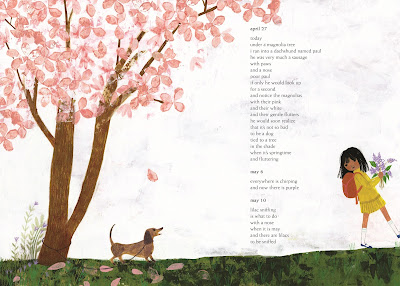 |
"lilac sniffing
is what to do
with a nose
when it is may
and there are lilacs
to be sniffed" |
Julie Morstad's artwork complements Fogliano's poetry, highlighting the delicate beauty of earth throughout the seasons. Children will notice that many of the poems are written as a journal from the girl on the cover, although she is never named and this isn't a journal with a story. Other pictures feature different children, perhaps her friends or perhaps other narrators.
Here is a poem perfect for Earth Day:
june 10
i don't know much about flowers
i don't know their names
or how they like to grow
in sun or shade
in morning or night
i don't know where they began
or how they traveled
by boat or by bird
and whether or not the rain makes them shiver or bloom
but i know how they lean
and bend toward the light
wide open as if singing
their voices (silent but everywhere)
fill up the daytime
a song much more than purple
and beyond every red
a song that makes me stop and listen
and forget
and not care at all
that i don't know much
about flowers.
-- by Julie Fogliano, When Green Becomes Tomatoes
This is a collection that I will enjoy dipping into time and time again, savoring phrases and images. It is definitely my favorite new poetry collection this year.
I'd also like to share a collection of poems I checked out to a family today. Francisco Alarcón celebrates the seasons in four collections of bilingual poems that have great kid appeal.
Laughing Tomatoes and Other Spring Poems
Jitomates Risueños y otros poemas de primavera
by Francisco Alarcón
illustrated by Maya Christina Gonzalez
Children's Book Press, 1997
Your local library
Amazon
ages 5-8
Alarcón shares short, accessible poems, creating snapshots of children's daily lives. They are full of warmth, family love and laughter--as you would expect from the delightful title. Maya Christina Gonzalez's exuberant illustrations help draw children to this book, setting the joyful tone right from the start.
I'm so happy this bilingual collection continues to appeal to children and families. The poem "Morning Sun" makes me smile, and reminds me that there is joy all around us.
Morning Sun
warming up
my bed
in the morning
the Sun
calls me
through the window
"wake up
get up
come on out"
--by Francisco Alarcón
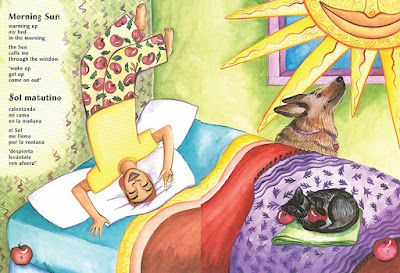 |
| "Morning Sun" |
Finally, I'd like to share a poem "Earth Day" by Jane Yolen that is reprinted on the Poetry Foundation website.
The Poetry Foundation website is a treasure trove of information. The foundation "is an independent literary organization committed to a vigorous presence for poetry in our culture. It exists to discover and celebrate the best poetry and to place it before the largest possible audience."
Earth Day
by Jane Yolen
I am the Earth
And the Earth is me.
Each blade of grass,
Each honey tree,
Each bit of mud,
And stick and stone
Is blood and muscle,
Skin and bone.
And just as I
Need every bit
Of me to make
My body fit,
So Earth needs
Grass and stone and tree
And things that grow here
Naturally.
That’s why we
Celebrate this day.
That’s why across
The world we say:
As long as life,
As dear, as free,
I am the Earth
And the Earth is me.
I hope you enjoy sharing a few poems on Earth Day.
Julie Fogliano, "june 10" from
When Green Becomes Tomatoes. Copyright © 2016 by Julie Fogliano. Illustration copyright © 2016 by Julie Morstad. Reprinted by permission of Macmillan. Francisco Alarcón, "Morning Sun" from
Laughing Tomatoes. Copyright © 1997 by Francisco Alarcón. Illustration copyright © 1997 by Maya Cristina Gonzalez. Shared with permission from Lee and LowBooks. Jane Yolen, "Earth Day" from
The Three Bears Holiday Rhyme Book. Copyright © 1995 by Jane Yolen. Reprinted by permission of Houghton Mifflin Harcourt.
The review copy of When Green Becomes Tomatoes was kindly sent by the publisher, Macmillan. If you make a purchase using the Amazon links on this site, a small portion goes to Great Kid Books. Thank you for your support.
©2016 Mary Ann Scheuer, Great Kid Books
.jpeg?picon=2320)
By: Mary Ann Scheuer,
on 4/20/2016
Blog:
Great Kid Books
(
Login to Add to MyJacketFlap)
JacketFlap tags:
Add a tag
I am honored to share today's interview with Nikki Grimes, one of my favorite authors. I am continuing my series interviewing California poets for young people--last week, I interviewed Jorge Argueta; in the works are interviews with Isabel Campoy and Lee Wardlaw. They each bring such wonderful gifts to our children.
Nikki Grimes has received many accolades for her writing, including the
2016 Virginia Hamilton Literary Award, the NAACP Image Award, the Coretta Scott King Award, and many more. I've seen time and again how she inspires my students, connecting with them on a very personal level. At
Reading Rockets, this introduction shows how her personal experiences helped shape her connections to reading and writing:
Nikki Grimes was born in Harlem, but grew up in many different parts of New York. As a foster child from a broken home, she moved from place to place, always saying goodbye to new friends. Reading and writing became her survival tools. When she had no one else to talk to, Grimes wrote poems and stories about the things that were bothering her. As an avid reader, she checked out library books by day and read at night by flashlight.
1. How do you get into a place or mindset for writing your poetry? Do you have any habits you could share with young writers?I pick up three or four books by favorite authors, written for the age group I'm writing that particular book for, and I'll lose myself in them for a day or so. This gets my pistons firing. I think something similar might work for any writer. After all, it's often the writing of authors that spur us to write ourselves.
2. I love sharing descriptive words with kids is there a word that's been on your mind lately that's particularly delicious?No single word comes to mind, but a new phrase popped into my head recently, which I love and just used in a keynote speech I gave this week:
the architecture of dreams! The phrase feels so good on my tongue.
3. What are three books of poetry you'd like to see in every child's home, for them to dip into whenever they want?Three is an impossibly short list of books, but I'll give you three of my favorites:Water Music by Jane Yolen; Come With Me by Naomi Shihab Nye; and Neighborhood Odesby Gary Soto. But they also need to have books by Langston Hughes, Joyce Sidman, Janet Wong, Paul Janezcko, Jack Prelutsky, Lucille Clifton—like I said, impossible!
4. Is there a poem you have memorized that you can share a snippet with us? Maybe it's something you say to yourself when you need encouragement or just when you want to delight in the power of words.Sorry. I don't memorize poems, not even my own.
Oh, I love that Nikki is giving us all permission NOT to memorize poems. I know that many people take great joy from reciting poetry, from having the words live permanently in their memory---but I have always struggled with this and felt very anxious about memorizing poems. How lovely to know that one of my favorite poets chooses to simply read and enjoy poetry without stressing about memorizing it.
I will hold the phrase architecture of dreams in my heart. I believe that the poetry, the books we share with our children help lay the foundations upon which they can build their own personal dreams. Nikki, I do hope you can share this speech (or a few parts of it) online.
If you want to read more interviews with Nikki Grimes, I highly recommend these:
Many thanks to Lee and Low Books for helping arrange this interview. And special thanks to Nikki for taking the time to answer these questions on a busy, celebratory weekend.
©2016 Mary Ann Scheuer, Great Kid Books

.jpeg?picon=2320)
By: Mary Ann Scheuer,
on 4/18/2016
Blog:
Great Kid Books
(
Login to Add to MyJacketFlap)
JacketFlap tags:
Add a tag
I have loved sharing Nikki Grimes' poetry and stories with students for years, and am delighted to share her most recent picture book today. Poems in the Attic shows how poetry can capture memories and connect generations together, as a young girl reads about her mother's childhood memories. Please join me later this week on Wednesday for an interview with Grimes.
Poems in the Attic
by Nikki Grimes
illustrated by Elizabeth Zunon
audiobook narrated by Sisi Aisha Johnson
Lee & Low Books, 2015
audiobook, Recorded Books, 2015
Your local library
Amazon
ages 6-9
While visiting her grandma, a seven-year-old girl discovers a cedar box filled with poems--written by her own mother when she was a girl. The girl today writes her own free verse, sharing her discoveries about her mother.
 |
| "Grandma's attic is stacked with secrets" |
The story unfolds with alternating voices, between the young girl and her mother's poems. Her mother describes her childhood experiences traveling from California to Alaska, and Germany to Japan as a military child.
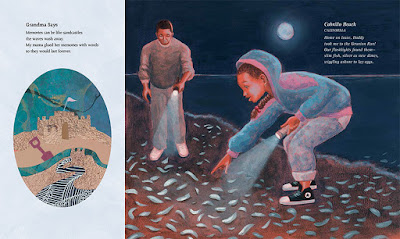 |
"Memories can be like sandcastles
the waves wash away.
My mama glued her memories with words
so they would last forever." |
I especially love the way the alternating voices let the poems show both internal reflections and special memories. In the page above, the modern young girl contemplates on the way words can "glue her (mother's) memories," so they last and can be shared. The mother's poem brings to life the memory of a special night outing with her dad. These memories act like Wordsworth's "spot of time," helping us savor the moment.
I have enjoyed sharing the picture book, with Elizabeth Zunon's warm illustrations. I have just listened to the audiobook and it's a delightful way to share this story, as well. Sisi Aisha Johnson conveys both the light, young voice of the narrator as well as the gentle, joyous rhythm of the poetry. In my view, the audiobook will work best in companion with the picture book, letting children read and hear the story at the same time.
Please join me on Wednesday for an interview with Nikki Grimes, as part of my series interviewing California poets for young people. The review copies were kindly sent by the publisher, Lee & Low Books. If you make a purchase using the Amazon links on this site, a small portion goes to Great Kid Books. Thank you for your support.
©2016 Mary Ann Scheuer, Great Kid Books
.jpeg?picon=2320)
By: Mary Ann Scheuer,
on 4/17/2016
Blog:
Great Kid Books
(
Login to Add to MyJacketFlap)
JacketFlap tags:
Add a tag
At Emerson this month, we are celebrating Arab American Heritage Month, to honor our Arab American students. We also want to provide a positive message to combat the persistent anti-Arab, anti-Muslim rhetoric we hear daily via our national media. I am so happy to be able to highlight the poet Naomi Shihab Nye.
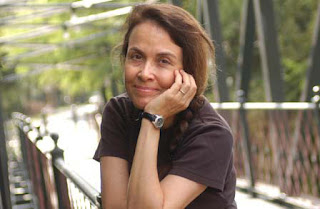 |
| Naomi Shihab Nye |
Naomi Shihab Nye, the daughter of a Palestinian father and an American mother, has lived in Ramallah in Jordan, the Old City in Jerusalem, and San Antonio, Texas. She writes for both children and adults. I first came to know her work through the book she edited:
This Same Sky: A Collection of Poems from Around the World.
Each week this month, I will be sharing one of her poems with our 4th & 5th graders as we celebrate Arab American Heritage Month. We are starting by watching this video, with Naomi Shihab Nye reading aloud her poem
"One Boy Told Me" from the PBS series
Poetry Everywhere.
This was a perfect introduction for my students, because it combined humor, poetic language and relatable experiences. I love the way they connect to a little kid's perspective. Here are just a few of their favorite lines:
"Oatmeal cookies make my throat gallop."
"Grown-ups keep their feet on the ground
when they swing. I hate that."
"My tongue is the car wash
for the spoon."
"My toes are dictionaries.
Do you need any words?"
see the full text of "One Boy Told Me" at the Poetry Foundation
In her writing, Naomi Shihab Nye has been inspired by her experiences as an Arab-American, as well as by life's little details. This is part of what I want to impart to students -- that poetry combines memories, small details and bigger ideas.
I will be sharing three poetry books and one picture book by Naomi Shihab Nye this month with my 4th & 5th graders:
I have collected my video resources for poetry month on my
YouTube Poetry Playlist. If you make a purchase using the Amazon links on this site, a small portion goes to Great Kid Books. Thank you for your support.
©2016 Mary Ann Scheuer, Great Kid Books

.jpeg?picon=2320)
By: Mary Ann Scheuer,
on 4/15/2016
Blog:
Great Kid Books
(
Login to Add to MyJacketFlap)
JacketFlap tags:
Add a tag
Like science, poetry asks students to slow down, observe and record. Many students are drawn to the way poetry distills these observations into brief lines. I am thrilled that the NPR show
Science Friday celebrated the union of poetry and science, creating two educational activities and recommending one of my favorite anthologies.
The Poetry of Science: The Poetry Friday Anthology for Science
edited by Sylvia Vardell & Janet Wong
illustrated by Frank Ramspott and Bug Wang
Pomelo Books, 2015
teacher's edition
Amazon
ages 4-10
Whether you want to take a moment to observe the way a hawk glides or predict what happens when you soak celery in food dye, these poems offer a short, focused crystallization of scientific observation and inquiry. Here's a great poem to start us off: "How to Be a Scientist" by
Amy Ludwig VanDerwater.
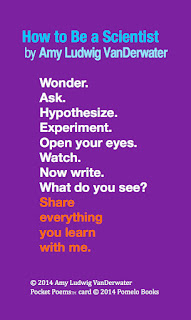 |
How to Be a Scientist
by Amy Ludwig VanDerwater |
This anthology offers over 200 poems written by 78 of today's most popular poets. Poems are organized by topics such as:
- What Do Scientists Do?
- Ask & Investigate
- Science Fair
- Kitchen Science
- Push & Pull
- Water, Water, Everywhere
- Earth & Sun
- Ecosystems
- Endangered & Extinct
- Think It, Build It, Make It
I love the
"Take 5" approach that editors Sylvia Vardell and Janet Wong have developed to share poetry in the classroom. This concise approach advocates taking time for poetry every Friday to introduce and share a poem—in this case a science-centric poem. For every poem, they provide “Take 5” activities for each poem to help teachers, librarians, and parents share poems. They invite students to listen and read along, and provide questions, activities, and book suggestions for considering the science content of each poem.
Definitely check out the
Poetry for Children Blog this month. Sylvia Vardell is sharing science and poetry resources all month long. Each day, she is sharing a poem, pairing it with a nonfiction picture book, and providing Take 5 activities.
Explore some of their resources on the
Pomelo Books Pinterest page. Here is one of my favorite poems,
Spiral Glide by Mary Lee Hahn, and the Take 5 activities that accompany it.
On Facebook, the folks at Science Friday shared this delightful poem movie to highlight the scientific inquiry. Notice how poet Susan Blackaby introduces students to academic, scientific words like hypothesis, observation, data and results -- but she does so with rhyme and rhythm.
The review copies were kindly sent by the publishers. If you make a purchase using the Amazon links on this site, a small portion goes to Great Kid Books. Thank you for your support.
©2016 Mary Ann Scheuer, Great Kid Books
Poetry holds a special place in my heart, for the way it helps me slow down and notice. As I share poetry with my students, it's very important to me to help them see that the poems we read have been created by real people. We need to help our children see that they, too, are poets.
I am thrilled to share interviews with California poets for young people. This month, I will share interviews with Jorge Argueta, Nikki Grimes, Isabel Campoy, and Lee Wardlaw. Please consider inviting these wonderful poets to your schools to connect in person with your students. In the meantime, let's welcome our first guest.
 |
| Jorge Argueta |
Jorge Argueta is a prolific Salvadoran poet who lives in San Francisco. I love sharing his bilingual poems and stories with children. Argueta immigrated to the United States more than 30 years ago in the midst of his country’s civil war. He writes poetry and children’s books, runs Luna’s Press and Bookstore in San Francisco, and gives poetry presentations and workshops in the US and in El Salvador.
Argueta’s two most recent books are
Salsa, a cooking poem illustrated by Duncan Tonatiuh (
see my review), and
Olita y Manyula: The Big Birthday/El gran cumpleaños, a sweet story illustrated by El Aleph Sanchez (see a review at
De Colores). I am so honored and happy to share this interview with you.
1. How do you get into a place or mindset for writing your poetry? Do you have any habits you could share with young writers?When I write a poem, I normally visualize it. If it’s a place or a person, I visit with them. In my imagination, I talk to the people, trees and fruits and vegetables. I live with them. I have an office, but I like to do my writing in my kitchen because I feel it is a place where I can dream. My tea kettle is a steam train, it brings people, cows, mountains, rainbows, rivers, moons, suns, stars, they all come to keep me company when I’m writing.
I love writing in my kitchen because it reminds me of my home in El Salvador. I have the sweet company of my family and friends, here I can bring the past to the present, to the future. In the kitchen I have chairs, tables, kitchen utensils and photos. I am surrounded by wonderful colorful vegetables and fruits, each with different shapes and scents. To me the kitchen is a place where I make connections with the whole world. Just as life, the kitchen is a poem.
2. I love sharing descriptive words with kids. What are some words that you have been thinking about lately, that might be particularly delicious?Water fire colors mango sunrise
I believe words were given to us to talk about our happiness, our sadness, our joy, our perseverance, our justice. As an indigenous person, a Latino person, I need to talk about our endurance. I believe words were given to me to talk about the needs of people for justice, and to see the world in different ways.
3. What are three (classics) books you’d like to see in every child’s home?The Popol-Vuh, 1001 Arabian Nights and Jungle Book.
There’s definitely classical literature that you can turn to, like The Popol–Vuh for children, a classical book by the great Mayan people, adopted for children by Ana Maria Dueñas, or The Jungle Book, by Rudyard Kipling, or picture books by Dr. Seuss. But I also want to share other poets’ work with children.
The great Chilean writer,
Gabriela Mistral, wrote for children’s and for social justice. She was awarded the Nobel prize for literature in 1945.
Pablo Neruda’s mind, his writing touches children, young adults and adults. His words are child-like, yet also powerful enough to touch anybody. Also a Nobel prize winner. In El Salvador,
Claudia Lars, wrote amazing poems for children.
Most recently, my good friend,
Juan Felipe Herrera--current Poet Laureate of the United States-- conveys the power and the tenderness to share the experience of the farm workers and Latino immigrants, to talk about important issues today.
Francisco Alarcón—another good friend who just passed away, wrote such fun poems for children, that make me laugh and smile and wonder.
A good message to convey to parents is the importance of the oral tradition. We are telling parents to make sure their children read, read, read -- but we also need to remind ourselves how important it is to keep the oral tradition alive. Tell children where they come from, who grandpa was, what he did as a young boy. We have beautiful family stories that we sometimes forget to tell our children.
4. Is there a poem you can share a snippet with us?I’d like to share a little from my newest book,
Olita y Manyula: The Big Birthday/El gran cumpleaños:My name is Holly
but my friends in El Salvador call me Olita
Spanish for little wave
I love to be called Olita,
little wave…
This fall, Jorge Argueta's next book will be published:
Somos como las nubes: We Are Like the Clouds (Groundwood Books, October 2016). Here is the description from the publisher:
Why are young people leaving their country to walk to the United States to seek a new, safe home? Over 100,000 such children have left Central America. This book of poetry helps us to understand why and what it is like to be them.
This powerful book by award-winning Salvadoran poet Jorge Argueta describes the terrible process that leads young people to undertake the extreme hardships and risks involved in the journey to what they hope will be a new life of safety and opportunity. A refugee from El Salvador’s war in the eighties, Argueta was born to explain the tragic choice confronting young Central Americans today who are saying goodbye to everything they know because they fear for their lives. This book brings home their situation and will help young people who are living in safety to understand those who are not.
Thank you so much for taking the time to visit with us, Mr. Argueta. It was a true delight and pleasure.
If you make a purchase using the Amazon links on this site, a small portion goes to Great Kid Books. Thank you for your support.
©2016 Mary Ann Scheuer, Great Kid Books
.jpeg?picon=2320)
By: Mary Ann Scheuer,
on 4/11/2016
Blog:
Great Kid Books
(
Login to Add to MyJacketFlap)
JacketFlap tags:
Add a tag
I'm so happy to share Salsa, a delightful poem and picture book which is the latest in Jorge Argueta's cooking poems. Argueta and Duncan Tonatiuh bring together music, dancing and food to celebrate salsa as a brother and sister work together to make for their family. Please join me later this week on Wednesday for an interview with Argueta.
Salsa: Un poema para cocinar / A Cooking Poem
by Jorge Argueta
illustrated by Duncan Tonatiuh
Groundwood Books, 2015
Google Books preview
Your local library
Amazon
ages 5-8
Argueta connects kids' enjoyment of salsa today to the cultural traditions of ancient Aztec, Mayan, and Nahua peoples in Central America. As we begin the story, we meet the molcajete, a type of stone bowl that ancient peoples made from volcanic rock and used to grind tomatoes, corn, chilies, vegetables and spices.
Please note, as you look at these samples, how the Spanish text comes before the English text. I especially appreciate the message this sends, showing the importance of Spanish language in conveying this poem.
 |
My mother tells me molcajetes were our ancestors' blenders. |
Just like their ancestors, the brother and sister sing and dance as they make their salsa. I love how Argueta brings the ingredients to life, describing each one as part of the "salsa orchestra". He conveys the joy of cooking, and shows how each ingredient brings the salsa its own sound and feeling.
"I am ready with four tomatoes.
They are bongos and kettledrums.
My onion is a maraca.
Cloves of garlic are trumpets,
and the cilantro is the orchestra conductor
with his shaggy, green hair."
Duncan Tonatiuh uses his signature style to illustrate in ancient Mixtec style. Faces are shown in profile, with big, swiveling heads and oversized hands. Borders, reminiscent of those used in the ancient codices, show the ingredients and the musical instruments.
 |
For the music to be really spicy,
it's important to use chilies.
My family loves hot peppers. |
The extended musical metaphor is well played throughout, adding texture, humor and description to the cooking process. A true delight to share at home, at school, anywhere.
Illustrations copyright ©2015 Duncan Tonatiuh, used with permission of the publisher, Groundwood Books. The review copy came from our school library. If you make a purchase using the Amazon links on this site, a small portion goes to Great Kid Books. Thank you for your support.
©2016 Mary Ann Scheuer, Great Kid Books
.jpeg?picon=2320)
By: Mary Ann Scheuer,
on 4/10/2016
Blog:
Great Kid Books
(
Login to Add to MyJacketFlap)
JacketFlap tags:
Add a tag
"Poetry matters. Poetry, like all art, gives shape and texture and depth of meaning to our lives." -- President Obama, celebrating the National Student Poet Program
Poetry has the ability to speak to us, to give us courage to speak out, to feel heard. It is crucial that we give our children the opportunity to discover poetry that speaks to them, that helps them see themselves or to see others. I was delighted to discover the
National Student Poet Program, especially the videos celebrating the 2015 winners.
The
National Student Poets Program is the country’s highest honor for young poets (grades 10–11) presenting original work.
Annually, five students are selected for one year of service as literary ambassadors, each representing a different geographic region of the country. By elevating and showcasing their work for a national audience, the program strives to inspire other young people to achieve excellence in their own creative endeavors and promote the essential role of writing and the arts in academic and personal success.
I have enjoyed exploring the
YouTube channel for the National Student Poets Program. It is incredibly inspiring to hear the different young poets share their poetry and talk about their year of service. I am looking forward to sharing with my students Chastity Hale's video:
"Poetry is significant to me because it is a lens where I can view the world and see things through different perspectives. I've always used poetry to further my understanding of other people and spread messages." -- Chastity Hale
You can watch the entire ceremony, in which First Lady Michelle Obama honors this year's five National Student Poets. I especially want to share
this section as Jacqueline Woodson, one of my all-time favorite poets, honors the poets.
Enjoy sharing these videos with young people in your life.
©2016 Mary Ann Scheuer, Great Kid Books
I am ridiculously excited to share Booked with kids, friends and librarians. Kwame Alexander hits the sweet spot again, this time scoring a goal with his mix of soccer, family, first crushes, friendship and poetry.
Booked
by Kwame Alexander
Houghton Mifflin Harcourt, 2016
Your local library
Amazon
ages 10-14
*best new book*
Nick
loves soccer, whether it's playing
futsol with his best friend, dreaming of playing professionally, or staying up late playing FIFA online. What Nick
hates are books. More specifically, he hates that his dad makes him read his own dictionary of unusual words.
Kwame Alexander has crafted a novel that is fast to read, full of wordplay and humor, and leaves you thinking. I love the way he captures the bantering between Nick and his mom, as well as between Nick and his best friend Coby. Right from the beginning, he shows how kids play with words in smart, sophisticated ways. My students love telling jokes, and will love seeing if their friends get this. Just see if they see why this is such a funny way for Nick to introduce his dad, the linguistics professor:
"In the elementary school spelling bee
when you intentionally
misspelled heifer,
he almost had a cow."
As Nick struggles with his parents' impending divorce, bullying at school and figuring out how to talk to the girl of his dreams, he discovers that words and poetry can actually be cool. A great follow up to
The Crossover!
Want to read more? Check out this terrific NPR interview with Kwame from this weekend:
How To Get Kids Hooked On Books? 'Use Poetry. It Is A Surefire Way'
-- NPR radio interview, April 3, 2016
I'm so jazzed to share this that I've already placed an order for 15 books (!!) with my favorite local bookstore, Mrs. Dalloway's, and I will be sharing these with friends tomorrow. I hope to share soon how kids respond to
Booked. My sense is that
Booked will resonate more with middle school students than elementary students, but I do think many 5th graders will enjoy and relate to Nick's struggles.
The review copy was kindly sent by the publishers, Houghton Mifflin Harcourt. If you make a purchase using the Amazon links on this site, a small portion goes to Great Kid Books. Thank you for your support.
©2016 Mary Ann Scheuer, Great Kid Books
Poetry can be a terrific way to explore different topics kids might want to learn more about. In particular, poetry and science make a great pair. Above all else, poets and scientists ask us to stop and notice the world around us. I love these two picture books that celebrate our fine feathered friends, and do it with terrific word play and illustrations.
Woodpecker Wham
by April Pulley Sayre
illustrated by Steve Jenkins
Henry Holt / Macmillan, 2015
Your local library
Amazon
ages 4-8
Sayre’s dynamic verse brings alive the sound and movement of six different woodpecker species as they chop, bonk, tap, and slam, doing serious work.
 |
"Swoop and land.
Hitch and hop.
Shred a tree stump.
Chop, chip, chop!" |
The bouncing, rhythmic verse and the bold illustrations make this a great read-aloud. As you read, ask kids which words they think have real pizzaz--notice Sayre's word choices. Whether she's showing how the birds fly or how their tapping sounds, Sayre chooses dramatic words. Encourage your kids to try using words like this on your next walk outside.
Every Day Birds
by Amy Ludwig VanDerwater
illustrated by Dylan Metrano
Orchard/Scholastic, 2016
Your local library
Amazon
ages 3-6
Short simple verses and cut-paper collage illustrations introduce young readers to common North American birds. Choosing birds that preschoolers like to notice, VanDerwater displays one bird on each page, highlighting a memorable characteristic for each.
 |
| "Chickadee wears a wee black cap." |
 |
| "Owl swoops soundlessly late at night." |
The bold illustrations focus young readers on each bird, setting each bird against a simple background helps highlight the species and the poetry. I especially like how VanDerwater focuses on one key feature of each bird, highlighting it with strong language. The endnotes provide more detail on each species for adults to share, as kids as more quesitons.
Together, the cumulative effect leads to a rhythm and rhyming scheme that makes for a lovely read-aloud for preschoolers. "Heron fishes with his bill./ Sparrow hops in brown./ Mockingbird has many voices./ Pigeon lives in town." Perfect for budding naturalists.
Illustrations from Woodpecker Wham copyright ©2015 Steve Jenkins, used with permission of the publisher. Text from Every Day Birds written by Amy Ludwig Vanderwater. Illustrations copyright 2016 by Dylan Metrano. Used with permission from Orchard Books/Scholastic. The review copies were kindly sent by the publishers, Macmillan and Scholastic. If you make a purchase using the Amazon links on this site, a small portion goes to Great Kid Books. Thank you for your support.
©2016 Mary Ann Scheuer, Great Kid Books
The Favorite Poem Project is dedicated to celebrating, documenting and encouraging poetry’s role in Americans’ lives. Founded by Robert Pinsky shortly after he was appointed the 39th Poet Laureate of the United States in 1997, this project has become a wonderful resource and inspiration.
It began as an initiative to create an audio and visual archive of 1,000 Americans reading aloud their favorite poems. Americans from every state and from all ages have submitted their favorite poems. I have loved exploring the resources available online, both video and audio recordings of Americans young and old sharing their favorite poems. Today, I'd like to share two favorite videos that particularly spoke to me.
Pov Chin, a student from Stockton, California, shares
Langston Hughes' "Minstrel Man". I love how she connects to this poem, how it helps her express her own experience as a teen.
You can find the full text of the poem at
PBS NewsHour, along with a transcript of Pov's reflections.
"I like it (Langston Hughes' poem) because it describes me. Like, I walk around with a smile on my face all the time at school and with friends and stuff, but I still have different thoughts running through my head. It’s never stable. It’s always going."
"We Real Cool" by Gwendolyn Brooks, is a poem that's often shared in middle school--I think that kids will respond to the way
John Ulrich, a student in South Boston, Massachusetts, reads it and talks about it.
John speaks about the "cluster of death" that has surrounded his neighborhood, from young people's deaths due to drug overdoses and depression. He also shares the program he started "South Boston Survivors", to help young people find creative sparks to redirect them from depression.
"When I first heard 'We Real Cool', ...it just made sense to me, how things started out so innocent and got so drastic so quick."
Yina Liang, a student in Decatur, Georgia, shows how she connects to
Emily Dickinson's poem "I'm nobody! Who are you?" I particularly like the way that Yina shows how she has to juggle all of the expectations she feels, all of the demands--and how sometimes, she just wants to escape and be nobody.
"I think I discovered this poem in 7th grade... Every year, as life gets busier, the poem keeps coming back to me and it connects so much better every time that I think, in time, it discovered me instead."
There are many more Favorite Poem Project videos that spoke to me as an adult, but today I wanted to share the ones that I think will particularly resonate with kids. I hope you enjoy exploring these resources as much as I have.
©2016 Mary Ann Scheuer, Great Kid Books
As we launch into National Poetry Month, I want to start by sharing Daniel Finds a Poem--an absolutely beautiful new picture book that celebrates finding poetry all around us. I adore watching spring burst forth--and this book inspires me to stop, pause and take note of all the wonder around me.
Daniel Finds a Poem
by Micha Archer
Nancy Paulsen Books / Penguin, 2016
Preview on Google Books
Your local library
Amazon
ages 5-9
"What is poetry?" Daniel wonders as he sees a sign announcing a poetry performance in his local park. In this picture book, Micha Archer helps children see that poetry can be a moment of stopping to notice what's around you--just catching that moment in time, that spot in a place you know.
 |
"On Monday morning, Daniel sees something new on the park gate: POETRY IN THE PARK...
'What is poetry?' Daniel says." |
As he wanders through his local park and neighborhood, Daniel watches and asks different animals for their views on what poetry is. With his dark curly hair and eyes full of wonder, Daniel soaks each detail. Notice how Archer keeps the child part of each moment, even though the story is really about poetry and nature. This helps keep the child reader part of the story each step of the way.
 |
"He looks up in surprise when he hears Spider say,
'To me, poetry is when morning dew glistens.'" |
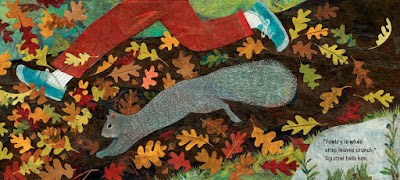 |
| "'Poetry is when crisp leaves crunch,' Squirrel tells him." |
Archer's illustrations are so lush, pulling readers into each scene, inviting them to linger and soak up the beauty just as Daniel does. I especially like the ending, as Daniel takes the small details each of the animals shares and creates his own found poem--and then performs it for a small audience in the park.
Share this delightful story and stop to notice the small details all around us. A wonderful introduction for poetry in the classroom or at home--best suited for kindergarten through 3rd graders as they start writing their own poems.
Illustrations ©2016 Micha Archer, used with permission of the publisher. The review copies were kindly sent by the publisher, Nancy Paulsen Books, and we have also purchased additional copies for our school library. If you make a purchase using the Amazon links on this site, a small portion goes to Great Kid Books. Thank you for your support.
©2016 Mary Ann Scheuer, Great Kid Books
It seems utterly perfect to start our celebration of National Poetry Month on April Fools Day with a collection of poems that will get kids laughing and sharing: Forgive Me, I Meant to Do It. It isn't politically correct. It isn't always nice. But it will get kids snickering and reading and wanting more. Share this snarky book with 4th and 5th graders, hand them a set of post-its, and ask them to mark their favorites.
Forgive Me, I Meant to Do It: False Apology Poemsby Gail Carson Levineillustrated by Matthew CordellHarperCollins, 2012
your local libraryAmazonages 8-10
This is just to say, open this book at your own risk. You'll find sarcastic takes on classic fairy tales. You'll find brothers being mean to sisters. You'll find authors sneering at their editors. But share it with the right kids, and you'll see them marking pages, showing friends and reading them again and again.
Each poem starts with a simple statement. There's no denying the wrong-doing.
I have eaten
your hot fudge
sundae
and the cherry on top
Then describe the effects. Show your point of view. Be blunt. But try to see what someone else's perspective might be.
which
I thoughtfully
replaced
with anchovies
End the last stanza with "Forgive me" but know that this is a false apology. You're really not sorry at all. And your reader knows it.
Forgive me
I gave three spoonfuls
of ice cream
to the cat
Add in Matthew Cordell's line drawings, and kids will be laughing and sharing.
I have to be honest. The first time I read this book, I didn't really get it. But when I shared it with kids, that's when I realized the true value of it. They had to read it with friends. They started debating which poem was best. They immediately got point of view, connected it to their experiences, and wanted more.
Snow White gets tired of the dwarves ("you snore/ pick your noses/ never take a bath") and runs off with the evil witch. Kids call up a genie and put parents behind bars ("Forgive me/
time-out and
grounded / and other unpleasant phrases/ can no longer be uttered").
Pure magic, in my view. And especially best shared on April Fools Day. Don't you think? For other reviews, check out Franki's at
A Year of Reading, Betsy's at
Fuse #8.
Poetry ©2012 by Gail Carson Levine, illustrations ©2012 by Matthew Cordell; used with permission from the publisher. The review copy came from our school library. If you make a purchase using the Amazon links on this site, a small portion goes to Great Kid Books. Thank you for your support.
©2015 Mary Ann Scheuer, Great Kid Books
.jpeg?picon=2320)
By: Mary Ann Scheuer,
on 3/29/2016
Blog:
Great Kid Books
(
Login to Add to MyJacketFlap)
JacketFlap tags:
poetry,
Add a tag
This April marks the 20th anniversary of National Poetry Month, and I am looking forward to celebrating it with friends near and far. It's been a difficult winter, and I've taken much needed time to focus on my family. Now that spring is bursting into bloom and we are on the mend, I'm happy to share books here once again.
How do you share poems with children? Do you have any advice to share? Here are my five top rules to go by:
1. Keep it short and share poetry often. Dip in and don't over-analyze. Enjoy what a poem has to offer and move on. Help kids see that there are all sorts of poems, and they get to choose the ones that they like. Maybe it's funny poems, maybe it's ones that twist a phrase unexpectedly, maybe it's poems with strong rhythm and rhyme that really sing to them.
2. Read poetry aloud. Share poetry by reading it aloud, for it was originally created as a spoken art. Encourage kids to read aloud poems they like. Read poems more than once -- showing kids that they might hear something new a second time around. If they complain, ask them if they listen to a favorite song only one time or over and over again.
3. Make it visual. I love poetry picture books for the way that illustrations add dimension to poetry. Take this idea and apply it to the way tweens and teens can appreciate poetry--sharing illustrated poems that speak to them. Some of the best projects I've seen are those where kids take or choose photographs to go with poetry. For a treasure-trove of examples, look at
printable poems and
poem pocket-cards from
Pomelo Books.
4. Create connections. Poetry is both personal and communal. It can be a very private experience or a shared one. Help children make meaning to their own lives by sharing poetry that connects to their own life experiences.
5. Celebrate the power of poetry. Find a way to honor the power of poetry. Host a poetry slam. Encourage kids to create
poetry movies or slideshows. Make a poetry wall with short quotes from favorite poems. Participate in
Poem In Your Pocket Day. Re-read your favorite collection of poems or discover a new poet.
All month, I'll be sharing favorite poetry books and resources that inspire kids. It's good to be back. I look forward to connecting and sharing books for kids with this community of children's book lovers.
©2016 Mary Ann Scheuer, Great Kid Books
View Next 25 Posts


.jpeg)

